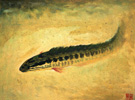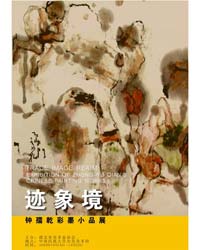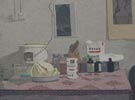“Li Jie is a good painter”
"Li Jie is a good painter" one day told me M.H, a precious friend who is also one of my favorite painters, with whom I often have good conversations on art. We have a pause. To say that someone is a good painter today seems to be somehow diminishing. "Artist" is a more comprehensive word and has a wider meaning. And, especially, is more suitable to that large group of people who nowadays work in art without creating it with their hands. How would one define someone who does not paint, nor sculpt, nor draws or photographs, but just describes ideas and asks someone else to execute them? Depending on how successful this person is in the media and commercial world, she/he has a good chance to be considered a great artist, mainly because, in my opinion, those who have the power to judge have, in their turn, long lost the ability and the sensibility to appreciate the 'non-conceptual' aspect of an artwork. But this aspect, I strongly believe, is still a very important aspect of making, appreciating and 'feeling' art.
"People here in Beijing told me I am too traditional, they told me that this kind of work won't go, because it is not contemporary". I listen to Li Jie's words in astonishment. I can't believe these kind of categories are still there, in people's mind, in today's China. I say 'still' because I know that, when the so-called contemporary art started to gain attention, everybody was afraid of not being contemporary enough.
Does it make sense? I ask myself. To me, not at all. To be contemporary is not a task; moreover, I don't agree that being contemporary means to be good. It might mean to be 'trendy', but trends pass fast, and I believe artists and their artworks would like to last. Why not wondering about the 'poetic', 'creative', 'unique', 'true', 'authentic' and, why not, even 'skilful' quality of an artwork, instead? Don't these qualities tell more, and more in depth, about an artwork than the definition of 'contemporary'? I think so.
I am not a trendy person, I have never been, and I am not keen on trendy people either. To be trendy is easy for anybody who is intelligent and clever. To achieve depth and to be true to oneself, to have something relevant to express is much more difficult. One has to see things clearly and to work hard to express them in the most suitable way, according to one's ability. One has to face loneliness, and the suspicion, skepticism, stupidity of the world around. One has to insist despite hardship, if one really feels the need to express her/himself. China is now very 'trendy' in the contemporary international art market, and for this very reason it is now more difficult to be oneself in China, as an artist, than it was in the past or, I believe and hope, than it will be in the future. Hopefully, trends will let place to something more durable and more meaningful.
Li Jie paints
Li Jie paints. She spends most of her time painting. I guess she enjoys it, she finds it meaningful. That's why she devotes her life to it. I have not seen the works she has produced before the current series, I imagine she has studied painting and, most likely, Chinese painting, because she masters the brush and the ink well.
When I first saw her works she was still in Luoyang, where she grew up and worked. Her paintings are difficult to photograph, the strokes are so subtle and the ink so pale that only the real works fully reveal their silent, non-spectacular flow.
It has been widely considered to be 'proper' for women painters, both in the East and in the West, to choose flowers and plants as a subject. A 'minor', intimate, domestic theme, suitable for the 'feminine' character. I have often found those vases of flowers painted by amateur female artists boring, obsolete, merely decorative. I might have been wrong in some cases, but I am still convinced about the majority. Li Jie has found inspiration in the vegetal world as well, but her plants are edible. Being a good cook, she must have been captured by the infinite variety of vegetables one can buy in the market, and have had the curiosity to translate them from a three-dimensional, colorful though short lifetime, to an immortal sphere made of grey strokes on a white background. I imagine her on the kitchen table, eyeing the eggplants and the beans she has bought for lunch, suddenly driven away by a need more urgent than appetite, taking out paper and brush, and starting to trace fine line after fine line, fascinated by the subtle elegance of each, lost in pleasure and excitement.
Like in Jesus's famous miracle of the "multiplication of breads and fishes", Li Jie's vegetables proliferate; the original one or two samples are drawn from every viewpoint and juxtaposed as if there were dozens of them. There is an endless abundance of each variety of vegetable, as if, through painting, she could provide enough food for her whole life, or if she was drawing the illustrations for a book of domestic botany.
Reading the titles of her early works I have the chance to review my Chinese lexicon. Pumpkins, carrots, radishes, bitter gourds, eggplants....a whole world is there. At first she keeps varieties separated, and collocates the subjects in the center of the painting, leaving a great deal of empty space around. Dimensions are quite small (45cm x 50cm), and the 'essence' of each vegetable is drawn with smoothness.
Later on Li Jie starts, I imagine, wondering how she can render these vegetables more 'cool', how she can add a conceptual value to them. By then she has decided she wants to spend time on this idea, and moves to Beijing.




